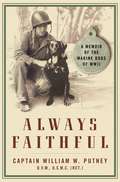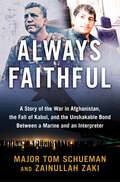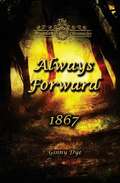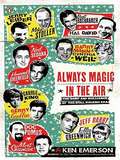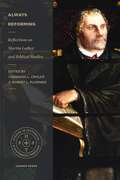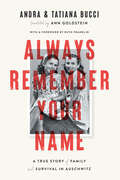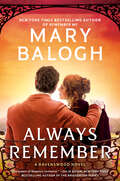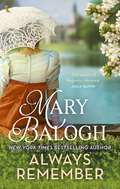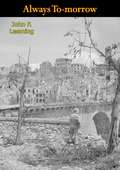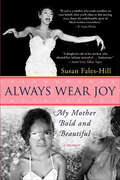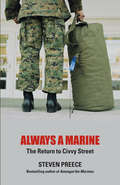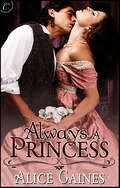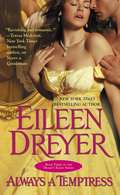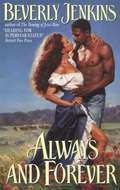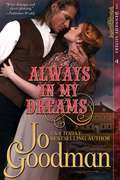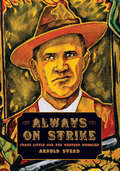- Table View
- List View
Always Faithful: A Memoir of the Marine Dogs of WWII
by William W. PutneyTwenty-three-year-old Bill Putney enlisted in the Marines in 1943 in search of military glory. Instead, Putney, a licensed veterinarian, was relegated to the Dog Corps. Putney became the Commanding Officer of the 3rd War Dog Platoon, and later the chief veterinarian and C.O. of the War Dog Training School at Camp Lejeune, North Carolina. At Lejeune Putney helped train America's dogs for war in the Pacific. He later led them into combat in the invasion of Guam in 1944, the first liberation of American soil in World War II. Always Faithful is the story of the dogs that fought in Guam and across the islands of the Pacific, a celebration of the four-legged soldiers that Putney both commanded and followed. It is a tale of immense courage, but also of incredible sacrifice. On Guam, as on islands such as Iwo Jima and Okinawa, the Japanese were infamously tenacious, refusing to surrender as long as there was a hole left to crawl into. Rooting out the enemy was an awful, painstaking job. To this task, Putney's dogs were well suited. Used for scouting, attack, carrying messages, detecting mines, and also as guards, the war dogs were so well trained that they could locate nonmetallic mines that had been buried for months deep underground; their hearing was so precise they could detect enemy trip wires by listening to them "sing" in the breeze. Their record in action was perfect. More than 550 patrols on the island of Guam were led by dogs; not one patrol was ambushed. But for this success, the dogs, always out in front, paid a terrible price. Although Putney worked feverishly as veterinarian and C.O. to keep the dogs alive, many were lost. After the war, Putney returned home only to discover that the dogs he had served with were being put to sleep. These dogs were ex-household pets, recruited from civilians with the promise that they would someday be returned. Outraged, Putney fought for the dogs' right to go home. He won, and headed the overwhelmingly successful program to "detrain" the dogs so they could return to their families. Alas, quickly learned, the lesson was quickly forgotten. The dogs of Korea and Vietnam did not come home. Then, in the final days of his administration, President Clinton signed into law a bill that allows military handlers to bring home the dogs with which they work. Once again, Putney was at the front of the charge. For anyone who has ever read Old Yeller, or the books of Jack London, here is a real-life story, never before told, that beats any fiction. At once wistful tribute and stirring adventure, Always Faithful describes what may be the greatest man-dog effort of all time. It will both astound and move you.
Always Faithful: A Story of the War in Afghanistan, the Fall of Kabul, and the Unshakable Bond Between a Marine and an Interpreter
by Thomas Schueman Zainullah ZakiBand of Brothers meets Argo in this dramatic and heartfelt dual memoir of the war in Afghanistan told by two men from opposite worlds. Always Faithful entwines the stories of Marine Major Tom Schueman, and his friend and Afghan interpreter, Zainullah “Zak” Zaki, as they describe their parallel lives, converging paths, and unbreakable bond in the face of overwhelming danger, culminating in Zak and his family’s harrowing escape from Kabul. In August of 2021, just days shy of the 20th anniversary of 9/11, America ended its longest war. The speed of the Afghanistan’s fall was so stunning that thousands of Afghan citizens who had helped American forces over the course of two decades—and had been promised visas in return—were suddenly stranded, in extreme, imminent danger. As the world watched the shocking scenes of desperation at the Kabul airport in the final two weeks of August, Maj. Tom Schueman fought—both behind the scenes and through a social media campaign—to get his friend and former Afghan interpreter, Zak, out of Afghanistan before he and his family were discovered by the Taliban. When Zak and his family finally took off from the airport mere days before the US left the country, the years-long effort to get Zak to America culminated in two simple words on Instagram: “Wheels up.”Now in Always Faithful, Tom and Zak tell the full story of the divergent paths that led them to Afghanistan, the dangerous road they walked together in service to America, and how their commitment to each other ended up saving them both. Brilliantly told in Tom’s and Zak’s alternating first person voices, Always Faithful tracks the parallel lives of these two men who each spent their childhoods in fear, peril, and poverty, and turned to war in attempt to build a meaningful future. On an inevitable course towards each other, their lives dovetail in Afghanistan’s deadly Helmand Valley, where they formed a brotherhood that transcends even the most overwhelming of odds, eventually culminating in Zak’s harrowing, eleventh-hour rescue.The end result is an intensely personal and uniquely ground-level account of Tom and Zak’s experience, Always Faithful gives readers a 360-degree view of the war. At once provocative and heart pounding, their stories together form a microcosm of the complicated and lasting effects of America’s longest war. Through their eyes and their experiences, they challenge readers to explore the legacy of the war for American and Afghan citizens alike, as we all collectively seek to understand whether twenty years of war was worth the price.
Always Forward (The Bregdan Chronicles Ser. #9)
by Ginny DyeBook number 9 of The Bregdan Chronicles, Always Forward, continues the sweeping historical saga of the Reconstruction. During this historical period, violence and hatred runs rampant throughout the country as America tries to come to grips with 2,000,000 formerly enslaved people. As far as the fictional characters are concerned, Carrie and Robert's dreams of his horse business thriving and her becoming pregnant come true. However, is Carrie strong enough to survive what follows? Next, Rose's school comes under attack by vigilantes. Finally, Abby chooses to go to Kansas to fight for Woman Suffrage and almost dies.
Always Magic in the Air
by Ken EmersonDuring the late 1950s and early 1960s, after the shock of Elvis Presley and before the Beatles spearheaded the British Invasion, fourteen gifted young songwriters huddled in midtown Manhattan's legendary Brill Building and a warren of offices a bit farther uptown and composed some of the most beguiling and enduring entries in the Great American Songbook. Always Magic in the Air is the first thorough history of these renowned songwriters-tunesmiths who melded black, white, and Latino sounds, integrated audiences before America desegregated its schools, and brought a new social consciousness to pop music.
Always Mine
by Sophia JohnsonA Timeless Love The great Lord Damron is no more than a shadowy, powerful presence in the ruins of Blackthorn Castle. But the compelling gaze of his portrait draws Lydia Hunter to stand before him--and fall through time to become his beloved Lady Brianna. A Fiery Passion A tempestuous man with an incendiary nature, whose fury on the battlefield quickly routs his foes, Lord Damron must claim his Scottish kingdom and his bride. But Briannas heart can be claimed in only one way--her way. And his iron strength is no match for her gentleness. . . Praise for Sophia Johnsons Risk Everything: "Risk Everything has every element of a classic Johanna Lindsey: biting repartee, steamy sexual tension, a bold heroine and powerful hero. Johnson knows how to spin a tale. . . an accomplished debut. "--Romantic Times, 4-star review "Very intense. . . " --New York Times bestselling author Susan Johnson on Risk Everything
Always Music in the Air: The Sound of Twin Peaks
by Scott RyanA first-time-ever exploration of the 290 songs from the entirety of win Peaks, sure to entice fans of the David Lynch-Mark Frost's cult classic that revolutionized TV, with brand-new interviews with Frost and several of the key composers and musicians involved."Where we're from, the birds sing a pretty song and there's always music in the air." When author Scott Ryan (Fire Walk With Me: Your Laura Disappeared, The Last Days of Letterman) heard those words on the television series Twin Peaks in 1990, he wanted to live there as well. Problem was, most of the music that played in Twin Peaks were not released. Only one soundtrack came out from the series, and one from the film. It wasn't until 2011 that director David Lynch and composer Angelo Badalamenti opened the archives and released every track on MP3. These tracks were never officially released and do not stream anywhere today. Ryan interviews band members who performed the songs and music editors and directors from the series and draws from archived interviews with the late Badalamenti and singer Julee Cruise. This book explores all the music that was in the air, from Cruise's 1989 release Floating into the Night through all the Twin Peaks soundtracks, the 2011 online releases called the Twin Peaks Archives, and the releases from Twin Peaks: The Return in 2017. Ryan conducts brand new-Interviews with Dean Hurley (composer for The Return, curator of the Twin Peaks Archive), Tim Hunter (director), Lori Eschler (music editor), David Slusser (composer, music editor), Kevin Laffey (A&R for Julee Cruise), Duwayne Dunham (editor, director), Kinny Landrum, (keyboards) and Al Regni (saxophone). Also included are excerpts from Ryan's 2018 interview with Cruise. Foreword by Brad Dukes (Reflections: An Oral History of Twin Peaks).
Always North
by Herb RomeroA saga of a family intertwined historically with southwest USA that begins in 1598, when King Phillip II directs resettlement from New Spain to a northern region. It provides an insight into lives of early Spaniard settlers lasting over four-hundred years.
Always Reaching: The Selected Writings of Anne Truitt
by Anne TruittAn expansive collection of texts providing insight into the inner life, creativity, and practice of the innovative American artist Anne Truitt Spanning more than fifty years, this comprehensive volume collects the letters, journal entries, interviews, lectures, reviews, and remembrances of the groundbreaking twentieth-century artist Anne Truitt (1921–2004). Alexandra Truitt, the artist&’s daughter and a leading expert on her work, has carefully selected these writings, most of which are previously unpublished, from the artist&’s papers at Bryn Mawr College as well as private holdings. Revelations about the artist&’s life abound. Among Truitt&’s earliest writings are excerpts from journals written more than a decade before her first artistic breakthrough, in which she establishes themes that would occupy her for decades. In later texts she shares uncommon insights into the practices of other artists and writers, both predecessors and peers. Like Truitt&’s published journals, these writings offer a compelling narrative of her development as an artist and efforts to find her voice as a writer. They show that Truitt&’s creative impulse to translate the inner workings of her mind into a symbolic language, so important to understanding her sculpture, predates her art.
Always Reforming: Reflections on Martin Luther and Biblical Studies (Studies in Historical and Systematic Theology)
by Robert L. Plummer Channing L. CrislerLuther challenges the academy to speak beyond itself. Whatever the theological malady, Martin Luther prescribed the same remedy: the word of God. For Luther, the Word was central to the Christian life. As a lover, translator, and interpreter of Scripture, Luther believed the Bible was too important to be left to academics. God's word has always been and must always be for God's people. What, then, can biblical studies learn from Luther? In Always Reforming, leading Lutheran, Reformed, and Baptist scholars explore Martin Luther as an interpreter of Scripture. The contributors elucidate central themes of Luther's approach to Scripture, place him within contemporary dialogue, and suggest how he might reform biblical studies. By retrieving Luther's voice for the conversations of today, the contributors embody a spirit that is always reforming.
Always Remember Your Name: A True Story of Family and Survival in Auschwitz
by Andra Bucci Tatiana BucciA haunting WWII memoir of two sisters who survived Auschwitz that picks up where Anne Frank's Diary left off and gives voice to the children we lost.On March 28, 1944, six-year-old Tati and her four-year-old sister Andra were roused from their sleep and arrested. Along with their mother, Mira, their aunt, and cousin Sergio, they were deported to Auschwitz. Over 230,000 children were deported to the camp, where Josef Mengele, the Angel of Death, performed deadly experiments on them. Only a few dozen children survived, Tati and Andra among them. Tati, Andra, and Sergio were separated from their mothers upon arrival. But Mira was determined to keep track of her girls. After being tattooed with their inmate numbers, she made them memorize her number and told them to &“always remember your name.&” In keeping this promise to their mother, the sisters were able to be reunited with their parents when WWII ended. An unforgettable narrative of the power of sisterhood in the most extreme circumstances, and of how a mother&’s love can overcome the most impossible odds, the Bucci sisters' memoir is a timely reminder that separating families is an inexcusable evil.
Always Remember: Ben's Story (A Ravenswood Novel #3)
by Mary BaloghLady Jennifer Arden and Ben Ellis know that a match between them is out of the question. Yet their hearts yearn for the impossible. Discover a new heartwarming story from New York Times bestselling author and beloved &“queen of Regency romance&” Mary Balogh.Left unable to walk by a childhood illness, Lady Jennifer, sister of the Duke of Wilby, has grown up to make a happy place for herself in society. Outgoing and cheerful, she has many friends and enjoys the pleasures of high society—even if she cannot dance at balls or stroll in Hyde Park. She is blessed with a large, loving, and protective family. But she secretly dreams of marriage and children, and of walking—and dancing.When Ben Ellis comes across Lady Jennifer as she struggles to walk with the aid of primitive crutches, he instantly understands her yearning. He is a fixer. It is often said of him that he never saw a practical problem he did not have to solve. He wants to help her discover independence and motion—driving a carriage, swimming, even walking a different way. But he must be careful. He is the bastard son of the late Earl of Stratton. Though he was raised with the earl&’s family, he knows he does not really belong in the world of the ton.Jennifer is shocked—and intrigued—by Ben&’s ideas, and both families are alarmed by the growing friendship and perhaps more that they sense developing between the two. A duke&’s sister certainly cannot marry the bastard son of an earl. Except sometimes, love can find a way.
Always Remember: Fall in love against the odds in this charming Regency romance (Ravenswood)
by Mary BaloghLady Jennifer Arden and Ben Ellis know that a match between them is out of the question. Yet their hearts yearn for the impossible. Discover a new heartwarming story from New York Times bestselling author and beloved 'queen of Regency romance' Mary Balogh.A match between them is out of the question . . .Left unable to walk by a childhood illness, Lady Jennifer, sister of the Duke of Wilby, has made a happy place for herself in society - even if she cannot dance at balls or stroll in Hyde Park. She is blessed with a loving, protective family, but secretly dreams of marriage, children, walking - and dancing.When Ben Ellis comes across Lady Jennifer as she struggles to walk with the aid of primitive crutches, he understands her yearning. He never saw a practical problem he did not have to solve, and he wants to help her discover her independence. But as the illegitimate son of the late Earl of Stratton he must be careful, for although raised with the earl's family, he knows he does not really belong in the world of the ton.Jennifer is shocked - and intrigued - by Ben's ideas, and both families are alarmed by the growing friendship and perhaps more that they sense developing. A duke's sister certainly cannot marry the illegitimate son of an earl. Except sometimes, love can find a way.Don't miss the first two Ravenswood novels, Remember Love and Remember Me - out now!Praise for Mary Balogh:'A grand mistress of the genre' Romantic Times'Balogh is the queen of spicy Regency-era romance, creating memorable characters in unforgettable stories' Booklist'Mary Balogh sets the gold standard in historical romance' Jayne Ann Krentz'A romance writer of mesmerising intensity, Mary Balogh has the gift of making a relationship seem utterly real and utterly compelling' Mary Jo Putney
Always There: A gripping saga where the past and the present threaten to collide
by Pamela EvansTwo sisters discover that meddling in the past can bring about both happiness and long forgotten, devastating secrets... Pam Evans, much-loved author of In the Dark Streets Shining, brings us another tale of love, family and hope, clouded by two sisters' heart-breaking past. Perfect for fans of Dilly Court and Lindsey Hutchinson. 'The leading characters are finely drawn... crisp prose... a superb and heartwarming read' - Irish IndependentIn 1930s London, two little girls are lonely and bewildered after the tragic death of their mother. Daisy and June are now destitute and must go to the local orphanage. Once there, they take comfort in each other but they are robbed of even this consolation when they are parted because June is taken away for adoption. Years later, although out of touch and worlds apart, both share a disturbing childhood memory which will connect them forever. A memory that takes on a ghastly significance when June discovers the reason they were abandoned...What readers are saying about Always There: 'Simple read, simple tale, simply engrossed! It is the sort of book that warrants a sequel' 'I thoroughly enjoyed another great story from Mrs E, I couldn't put the kindle down'
Always There: A gripping saga where the past and the present threaten to collide
by Pamela EvansTwo sisters discover that meddling in the past can bring about both happiness and long forgotten, devastating secrets... Pam Evans, much-loved author of In the Dark Streets Shining, brings us another tale of love, family and hope, clouded by two sisters' heart-breaking past. Perfect for fans of Dilly Court and Lindsey Hutchinson. 'The leading characters are finely drawn... crisp prose... a superb and heartwarming read' - Irish IndependentIn 1930s London, two little girls are lonely and bewildered after the tragic death of their mother. Daisy and June are now destitute and must go to the local orphanage. Once there, they take comfort in each other but they are robbed of even this consolation when they are parted because June is taken away for adoption. Years later, although out of touch and worlds apart, both share a disturbing childhood memory which will connect them forever. A memory that takes on a ghastly significance when June discovers the reason they were abandoned... What readers are saying about Always There: 'Simple read, simple tale, simply engrossed! It is the sort of book that warrants a sequel' 'I thoroughly enjoyed another great story from Mrs E, I couldn't put the kindle down'
Always To-morrow
by John F. LeemingIn November 1940, an R.A.F. aeroplane crashed near Catania, Sicily. On board were Air Marshal O. T. Boyd on his way to Cairo as Air Officer Commanding Middle East, and John Leeming, a member of his staff, who before the war was a well-known private pilot and the author of several amusing books. Air Marshal Boyd and Mr. Leeming were taken prisoner by the Italians and, six months later, they were joined by a bevy of generals and other senior British officers, including Major-General Neame, V.C., Lieutenant-General O’Connor, Major-General Carton de Wiart, V.C., and Major-General Gambier-Perry.Always To-morrow, which was first published in 1951, is an account of the life as prisoners of war in Italy of this group of high ranking officers, beginning with the aircraft crash in Sicily which wrecked the career of Air Marshal Boyd.Widely regarded as one of the most amusing books written about World War II, the hopes and disappointments of the several attempts at escape are told in a most entertaining way, and the lack of emphasis on the less amusing aspects of life as a prisoner of war only serves to underline the unfailing courage, enterprise and patience of these senior officers.“The funniest war story of all, Leeming’s adventures as a prisoner of the Italians are told with a rare humour and a keen eye for the absurd. There is drama, too, in his story, but Mr. Leeming is irrepressible.”—Sunday Graphic
Always Wear Joy: My Mother Bold and Beautiful
by Susan Fales-HillFrom an inside peek at the inner workings of Hollywood to the backstage drama of Broadway, from a poignant look at the black upper class to an honest look at the WASP elite, this elegantly wrought memoir of an extraordinary family has something for everyone.Growing up with a black Auntie Mame-like mother (who performed with the likes of Lena Horne) and an Anglo sea-faring father, Susan Fales-Hill moved seamlessly between many worlds. But it was from her mother -- a woman who was dressed by Givenchy and sculpted by Alexander Calder, yet rejected by many a casting agent for her "dark," unconventional looks -- that Susan drew inspiration, particularly when she faced challenges in her own career as a television writer in Hollywood, a town that wasn't always receptive to positive images of people of color. As a result the two developed a bond that mothers and daughters everywhere will find inspiring. Both a universally touching mother-daughter story and a portrait of a dazzling American family, Always Wear Joy is a memoir readers won't soon forget.
Always Young and Restless: My Life On and Off America's #1 Daytime Drama
by Dana L. Davis Melody Thomas ScottThe renowned actress who played Nikki Newman on The Young and the Restless opens up about her sixty-year career in this scintillating memoir.Melody Thomas Scott admits she is nothing like her character on The Young and the Restless, who&’s seen it all in her forty-year tenure on America&’s highest-rated daytime serial. But there&’s plenty of drama beyond her character&’s plotlines. In this captivating memoir, Melody reveals the behind-the-scenes saga of her journey to stardom and personal freedom.As Nikki went from impoverished stripper to vivacious heroine, Melody underwent her own striking transformation, becoming a household name in the process. Raised by her abusive grandmother, Melody acted in feature films with Alfred Hitchcock, John Wayne, and Clint Eastwood—and endured abuse of industry men before taking control of her life and career in a daring getaway move. Melody shares all this, plus juicy on-and-off-set details of what it&’s like to be one half of the show&’s most successful supercouple, &“Niktor.&” In witty, warm prose, readers meet the persevering heart of an American icon. Prepare to be moved by a life story fit for a soap opera star.
Always a Marine: The Return to Civvy Street
by Steven PreeceIn Amongst the Marines, Steven Preece vividly depicted his excessive, violent lifestyle as an elite Royal Marine Commando. Now Always a Marine covers the author's struggle to leave that lifestyle behind following his departure from the service. Back on civvy street for the first time in over seven years, Preece finds it extremely difficult to adapt and struggles to shake off the belligerent mentality he developed while in the Marines. Despite these difficulties, he marries and starts a family, but this positive change is not enough to turn his life around. Preece soon discovers that his tendency towards violence will not be tolerated in the civilian workplace and, after finding himself blacklisted by many companies in his area, he is forced to look for employment abroad. This quest for work takes Preece to France, where he is caught up in a hotel fire; Germany, where he is double-crossed out of his job and later teams up with an ex-SAS trooper; Morocco, where an incident lands him in jail and he is later shot at by border police; and Thailand, where he fights in a boxing ring with a former French Legionnaire and gets caught up in a business scam.Having settled back in the UK, Preece's behaviour remains excessive. He severely injures his head and suffers minor brain damage after a heavy-drinking session. Upon recovering, he looks for something else to believe in and begins training in ninjutsu, the martial art of the ninjas, who view aggression as a sign of weakness. This, combined with the love of his family, finally enables him to put his past behind him. Always a Marine is the action-packed, often shocking account of one ex-Marine's 13-year struggle to control the aggression he learnt as a serviceman in order to become a respectable civilian.
Always a Princess
by Alice GainesEve Stanhope masquerades as a foreign princess at ton parties, stealing jewels from the nobility she despises and returning to her London slum at the end of the night. She's carefully plotting revenge on her former employer-a society cad who's ruined her reputation. Now it's her turn to ruin him. What she doesn't expect is to encounter the criminally handsome Orchid Thief on one of her heists...Philip Rosemont, Viscount Wesley, is also in disguise. Bored and stifled by society, he steals jewels for fun and leaves orchids as his calling cards. He knows the woman he's cornered at the ball is no aristocrat, much less the Princess of Valdastock. But something tells him she's not exactly common, either. Now he must uncover her motives while he enjoys her illicit kisses. Can these two become partners in crime even as they give in to their mutual seduction? Previously published, newly revised by author.83,000 words
Always a Scoundrel (Notorious Gentlemen #3)
by Suzanne EnochNever a gentleman . . . until now. Lord Bramwell Johns, the second son of a duke, is an unrepentant scoundrel. Now that his two closest friends are disgustingly ensconced in domestic bliss, Bram is feeling strangely restless. And not even relieving London's least deserving artistocrats of their ill-gotten jewels is enough--until the night he overhears an argument. It seems that Lady Rosamund Davies is about to be forced into marriage with a rogue even worse than himself. Rose is well aware of Bram's scandalous reputation, so any reason for his sudden interest in her is suspect; more so since he's close friends with the man about to ruin her family! She has her own plan though, and Bram may be just what she requires--as long as she remembers that he is only looking out for himself. As long as she remembers that his kisses and caresses don't mean anything. As long as she can keep from wondering whether she can trust a scoundrel . . . with her heart.
Always a Stranger
by Amara RoyceWhen two worlds collide, anything is possible. . .An international affair, London's Great Exhibition has taken the city by storm. As its newest Royal Commissioner, Lord Skyler Ridgemont must ensure the performers are properly contracted. Among them is the delicate and graceful Hanako Sumaki. Draped in vivid silk robes, Hanako's exotic Japanese fan dance captivates Skyler--and he longs to learn more about her. . .But Hanako's enigmatic employer keeps his exquisite charge very close. The consummate artist, she shows the handsome nobleman many faces, but never her true heart, which holds a desperate secret. When Skyler learns the real reason Hanako has been brought to London, he will risk his entire world to win her trust--and save her from losing both body and soul. It's a feat that will require the type of courage only love can give. . .81,000 Words
Always a Temptress (Drake's Rakes #3)
by Eileen DreyerHis greatest battle is just beginning . . .Captain Harry Lidge has done his duty. After losing too many good men on the battlefield, he's ready to put his responsibilities behind him and live a life free of care. But first he has one last mission: find out what the most outrageous woman in London, the same woman who betrayed him nearly a decade earlier, is concealing, before her secrets take down the crown.Her heart is the only thing she won't risk . . . Surrounded by ardent admirers and a few loyal friends, Lady Kate Seaton glides through the ton on a confection of couture gowns and bon mots. No one suspects that beneath her lighthearted façade Kate hides a sorrow so scandalous she'll do anything to keep it hidden. But only when she trusts Harry with the truth and only when he trusts her with his heart can they stop the villains all too willing to kill Kate to attain their ultimate goal: destroy England
Always and Forever
by Beverly JenkinsA desperate need Sassy Grace Atwood never expected to find her proper self accidentally tumbling into a stranger's bed. If she weren't desperate for a man to lead a wagon train of brides to a woman-starved town out West, she never would have gone near Jackson Blake-former lawman or not. She should send the ruggedly charming Texan packing...only he's perfect for the job. Now if her mind would just stop going blank every time she looked at him, they might get this train to Kansas yet. A comsuming passion What's a man to do when a beautiful woman leans over his bed in the middle of the night? Come to think of it, that was the only time Blake's ever seen the straitlaced Miss Atwood the least bit ruffled. He's certain that beneath her buttoned-up appearance lies a passionate woman aching to break free. But though Blake longs to take her in his arms, all he can offer Grace is a life on the run. And when the demons from his past catch up with them, Blake is couaght between the ties that bind and a love that could last...always and forever.
Always in My Dreams (The Dennehy Sisters Series #4)
by Jo GoodmanNew York heiress, Mary Schyler "Skye" Dennehy has the heart of an adventurer. No two tomorrows should ever be the same. So, when Skye's railroad mogul father asks her to investigate the progress of a world-changing invention, Skye secures a housekeeping position in the home of the reclusive inventor.Walker Caide, the inventor's hired muscle, instinctively knows something isn't quite right about Skye. He also knows what Skye really want's from life. Hiding his own past, Walker shares his passion.But a shadowy enemy is stalking them both, placing Skye between two dangerous men and a treasure of unimaginable proportions.REVIEWS:"A romance to savor." ~Library JournalTHE DENNEHY SISTERS SERIES, in series order:Only My LoveMy Heart's DesireForever in My HeartAlways in My DreamsOnly in My ArmsTHE MARSHALL BROTHERS SERIES in order:Her Defiant HeartHis Heart's RevengeTHE THORNE BROTHERS TRILOGY, in series order:My Steadfast HeartMy Reckless HeartWith All My Heart
Always on Strike
by Arnold SteadThough widely recognized as one of the Industrial Workers of the World's leading members and one of its most prominent militants, this is the first book-length biography of Frank Little. Little's life offers innumerable lessons for working class people facing many of the same economic injustices in today's world. Arnold Stead, PhD, is a poet, fiction writer, historian, playwright, and jazz and film critic. He lives in Minneapolis, Minnesota, with his wife and family.
